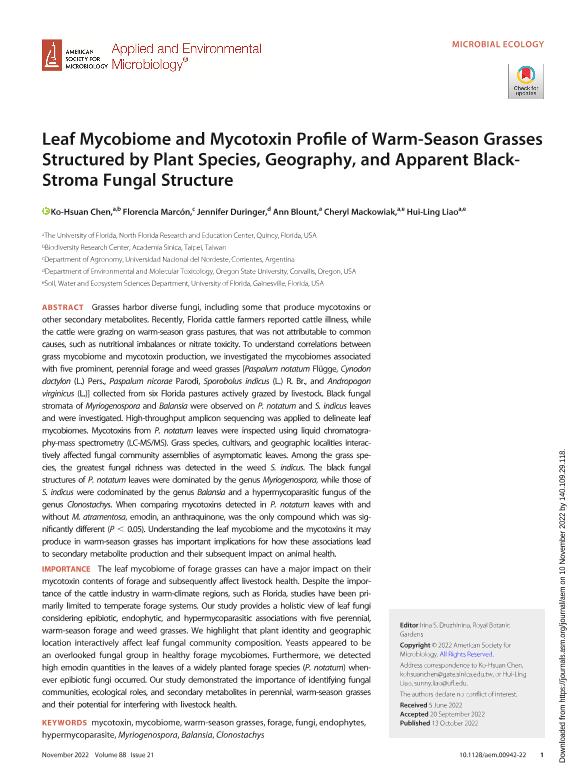Artículo
Leaf Mycobiome and Mycotoxin Profile of Warm-Season Grasses Structured by Plant Species, Geography, and Apparent Black- Stroma Fungal Structure
Chen, Ko Hsuan; Marcón, Florencia ; Duringer, Jennifer; Blount, Ann; Mackowiak, Chery L.; Liao, Hui Ling
; Duringer, Jennifer; Blount, Ann; Mackowiak, Chery L.; Liao, Hui Ling
 ; Duringer, Jennifer; Blount, Ann; Mackowiak, Chery L.; Liao, Hui Ling
; Duringer, Jennifer; Blount, Ann; Mackowiak, Chery L.; Liao, Hui Ling
Fecha de publicación:
11/2022
Editorial:
American Society for Microbiology
Revista:
Applied and Environmental Microbiology
ISSN:
0099-2240
Idioma:
Inglés
Tipo de recurso:
Artículo publicado
Clasificación temática:
Resumen
Grasses harbor diverse fungi, including some that produce mycotoxins or other secondary metabolites. Recently, Florida cattle farmers reported cattle illness, while the cattle were grazing on warm-season grass pastures, that was not attributable to common causes, such as nutritional imbalances or nitrate toxicity. To understand correlations between grass mycobiome and mycotoxin production, we investigated the mycobiomes associated with five prominent, perennial forage and weed grasses [Paspalum notatum Flügge, Cynodon dactylon (L.) Pers., Paspalum nicorae Parodi, Sporobolus indicus (L.) R. Br., and Andropogon virginicus (L.)] collected from six Florida pastures actively grazed by livestock. Black fungal stromata of Myriogenospora and Balansia were observed on P. notatum and S. indicus leaves and were investigated. High-throughput amplicon sequencing was applied to delineate leaf mycobiomes. Mycotoxins from P. notatum leaves were inspected using liquid chromatography- mass spectrometry (LC-MS/MS). Grass species, cultivars, and geographic localities interactively affected fungal community assemblies of asymptomatic leaves. Among the grass species, the greatest fungal richness was detected in the weed S. indicus. The black fungal structures of P. notatum leaves were dominated by the genus Myriogenospora, while those of S. indicus were codominated by the genus Balansia and a hypermycoparasitic fungus of the genus Clonostachys. When comparing mycotoxins detected in P. notatum leaves with and without M. atramentosa, emodin, an anthraquinone, was the only compound which was significantly different (P < 0.05). Understanding the leaf mycobiome and the mycotoxins it may produce in warm-season grasses has important implications for how these associations lead to secondary metabolite production and their subsequent impact on animal health.
Archivos asociados
Licencia
Identificadores
Colecciones
Articulos(IBONE)
Articulos de INST.DE BOTANICA DEL NORDESTE (I)
Articulos de INST.DE BOTANICA DEL NORDESTE (I)
Citación
Chen, Ko Hsuan; Marcón, Florencia; Duringer, Jennifer; Blount, Ann; Mackowiak, Chery L.; et al.; Leaf Mycobiome and Mycotoxin Profile of Warm-Season Grasses Structured by Plant Species, Geography, and Apparent Black- Stroma Fungal Structure; American Society for Microbiology; Applied and Environmental Microbiology; 88; 21; 11-2022; 1-19
Compartir
Altmétricas



